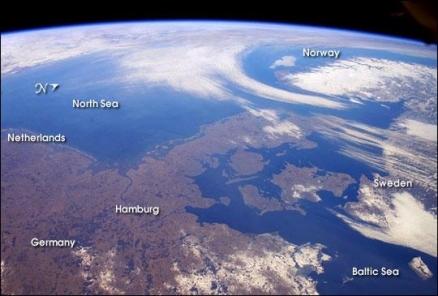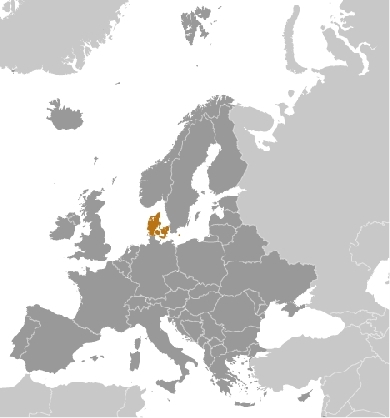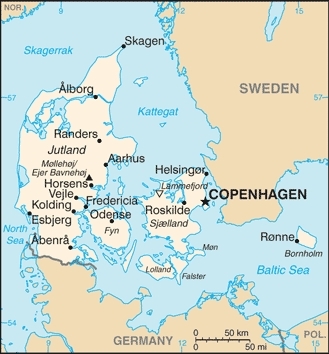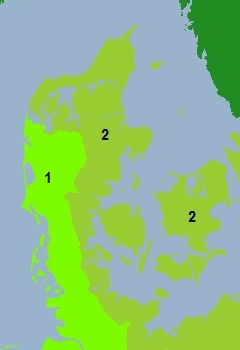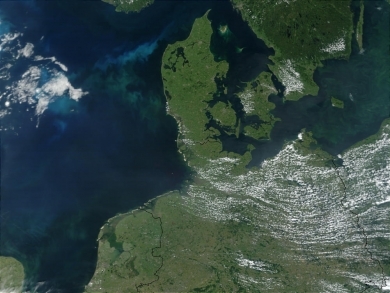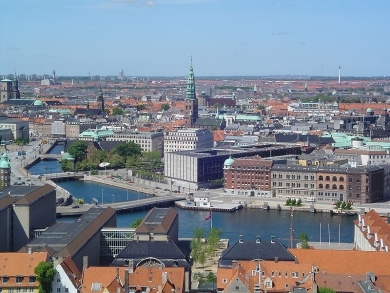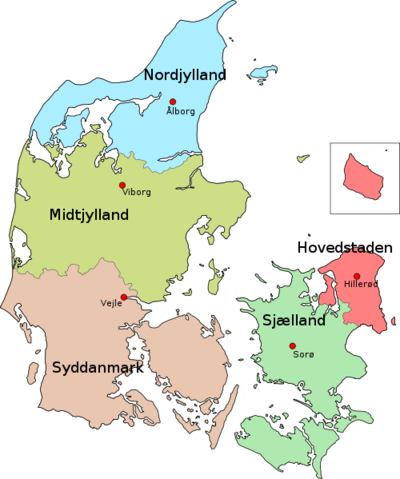Denmark
Countries and Regions of the World Collection  Denmark is a nation of just over five-and-a-half million people in Northern Europe, bordering the Baltic Sea and the North Sea, on a peninsula north of Germany (Jutland) and includes roughly 500 islands, including several major islands (Sjaelland, Fyn, and Bornholm). It is a part of the generally fertile and mostly agricultural region known as the North European Plain. This entire region is generally flat to slightly rolling and is overlain with glacial deposits.
Denmark is a nation of just over five-and-a-half million people in Northern Europe, bordering the Baltic Sea and the North Sea, on a peninsula north of Germany (Jutland) and includes roughly 500 islands, including several major islands (Sjaelland, Fyn, and Bornholm). It is a part of the generally fertile and mostly agricultural region known as the North European Plain. This entire region is generally flat to slightly rolling and is overlain with glacial deposits.
Denmark also includes the Faroe Islands and Greenland.
Its major environmental issues include:
- air pollution, principally from vehicle and power plant emissions;
- nitrogen and phosphorus pollution of the North Sea;
- drinking and surface water becoming polluted from animal wastes and pesticides
Flooding is a threat in some areas of the country (e.g., parts of Jutland, along the southern coast of the island of Lolland) that are protected from the sea by a system of dikes.
Once the seat of Viking raiders and later a major north European power, Denmark has evolved into a modern, prosperous nation that is participating in the general political and economic integration of Europe.
It joined NATO in 1949 and the EEC (now the European Union) in 1973. However, the country has opted out of certain elements of the European Union's Maastricht Treaty, including the European Economic and Monetary Union (EMU), European defense cooperation, and issues concerning certain justice and home affairs.
Denmark controls the Danish Straits (Skagerrak and Kattegat) linking the Baltic and North Seas.
About one-quarter of the population lives in greater Copenhagen.
Faroese continue to study proposals for full independence. Denmark in involved in sovereignty dispute with Canada over Hans Island in the Kennedy Channel between Ellesmere Island and Greenland.
Denmark (Greenland) and Norway have made submissions to the Commission on the Limits of the Continental shelf (CLCS) and Russia is collecting additional data to augment its 2001 CLCS submission
Contents
Geography
Location: Northern Europe, bordering the Baltic Sea and the North Sea, on a peninsula north of Germany (Jutland); also includes several major islands (Sjaelland, Fyn, and Bornholm)
Geographic Coordinates: 56 00 N, 10 00 E
Area: 43,094 sq km (land: 42,434 sq km; water: 660 sq km) Note: includes the island of Bornholm in the Baltic Sea and the rest of metropolitan Denmark (the Jutland Peninsula, and the major islands of Sjaelland and Fyn), but excludes the Faroe Islands and Greenland.
Land Boundaries: 68 km with Germany
Coastline: 7,314 km
Maritime Claims:
territorial sea: 12 nm
contiguous zone: 24 nm
exclusive economic zone: 200 nm
continental shelf: 200 m depth or to the depth of exploitation
Iceland, the UK, and Ireland dispute Denmark's claim that the Faroe Islands' continental shelf extends beyond 200 nm.
Natural Hazards: flooding is a threat in some areas of the country (e.g., parts of Jutland, along the southern coast of the island of Lolland) that are protected from the sea by a system of dikes
Terrain: low and flat to gently rolling plains. The highest point is Mollehoj/Ejer Bavnehoj (171 m) and the lowest point is Lammefjord (-7 m)
Climate: temperate; humid and overcast; mild, windy winters and cool summers.
Ecology and Biodiversity
|
The ecoregions of Denmark consist of two chief units:
Most of these temperate forests have been substantially destroyed or fragmented, chiefly through conversion to agricultural uses over the last several millennnia. Although the Faroe Islands and Greenland are both self-governing entities within the Kingdom of Denmark, the ecoregions of those geographic units are treated in separate articles. In addition to the two forest ecoregions, there is a recognizable ecosystem along the coastal zone of southern Jutland which consists of expansive tidelands, mudflats and marshes; this area includes not only the continental coast but the area comprised by numerous low-lying islands along the very shallow Wadden Sea. See also:
|
Ecoregions of Denmark. Source: World |
|
This MODIS true-color image shows the blues and greens of a phytoplankton bloom occurring in the North Sea, west of Denmark. The country on the peninsula in the center. The bright blue color may indicate a coccolithophore bloom. Source: NASA. |
| Copenhagen, the capital of Denmark. Source: Wikipedia. |
| This is the northmost point of Jylland, Denmark. The very northmost projection of land is called Grenen in Danish, and the general area is, just as the nearby town, called Skagen. Source: Martin Olsson/Wikipedia |
People and Society
Population: 5,543,453 (July 2012 est.)
Ethnic groups: Scandinavian, Inuit, Faroese, German, Turkish, Iranian, Somali
Age Structure:
0-14 years: 17.6% (male 500,265/female 474,829)
15-64 years: 65.3% (male 1,811,198/female 1,798,507)
65 years and over: 17.1% (male 417,957/female 527,132) (2011 est.)
Population Growth Rate: 0.239% (2012 est.)
Birthrate: 10.22 births/1,000 population (2012 est.)
Death Rate: 10.19 deaths/1,000 population (July 2012 est.)
Net Migration Rate: 2.36 migrant(s)/1,000 population (2012 est.)
Life Expectancy at Birth: 78.78 years
male: 76.39 years
female: 81.31 years (2012 est.)
Total Fertility Rate: 1.74 children born/woman (2012 est.)
Languages: Danish, Faroese, Greenlandic (an Inuit dialect), German (small minority) Note: English is the predominant second language.
Literacy: (age 15 and over can read and write) 99% (2003 est.)
Urbanization: 87% of total population (2010) growing at an annual rate of change of 0.4% (2010-15 est.)
History
The Danes, a homogeneous Gothic-Germanic people, have inhabited Denmark since prehistoric times. Danish is the principal language. English is a required school subject, and fluency is high. A small German-speaking minority lives in southern Jutland; a chiefly Inuit population inhabits Greenland; and the Faroe Islands have a Nordic population with its own language. Education is compulsory from ages seven to 16 and is free through the university level.
Although religious freedom is guaranteed, the state-supported Evangelical Lutheran Church has a membership of 80.7% of the population. Several other Christian denominations, as well as other major religions, find adherents in Denmark. The number of Muslims in Denmark estimated at 3.6% of the population.
During the Viking period (9th-11th centuries), Denmark was a great power based on the Jutland Peninsula, the Island of Zealand, and the southern part of what is now Sweden. In the early 11th century AD, King Canute united Denmark and England for almost 30 years.
Viking raids brought Denmark into contact with Christianity, and in the 12th century, crown and church influence increased. By the late 13th century, royal power had waned, and the nobility forced the king to grant a charter, considered Denmark's first constitution. Although the struggle between crown and nobility continued into the 14th century, Queen Margrethe I succeeded in uniting Denmark, Norway, Sweden, Finland, the Faroe Islands, Iceland, and Greenland under the Danish crown. Sweden and Finland left the union in 1520; however, Norway remained until 1814. Iceland, in a "personal union" under the king of Denmark after 1918, became independent in 1944.
The Reformation was introduced in Denmark in 1536. Denmark's provinces in today's southwestern Sweden were lost in 1658, and Norway was transferred from the Danish to the Swedish crown in 1814, following the defeat of Napoleon, with whom Denmark was allied.
The Danish liberal movement gained momentum in the 1830s, and in 1849 Denmark became a constitutional monarchy. After the war with Prussia and Austria in 1864, Denmark was forced to cede Schleswig-Holstein to Prussia and adopt a policy of neutrality. Toward the end of the 19th century, Denmark inaugurated important social and labor market reforms, laying the basis for the present welfare state.
Denmark remained neutral during World War I. Despite its declaration of neutrality at the beginning of World War II, it was invaded by the Germans in 1940 and occupied until liberated by the Allied forces in May 1945. Resistance against the Germans was sporadic until late 1943. By then better organized, the resistance movement and other volunteers undertook a successful rescue mission in which nearly the entire Jewish population of Denmark was shipped to Sweden (whose neutrality was honored by Germany). However, extensive studies are still being undertaken for the purpose of establishing a clearer picture of the degree of Danish cooperation--official and corporate--with the occupying power. Denmark became a charter member of the United Nations and was one of the original signers of the North Atlantic Treaty.
Denmark's relatively quiet and neutral role in international affairs abruptly changed when the Danish newspaper Jyllands-Posten printed 12 caricatures of Mohammed on September 30, 2005. Islamic law prohibits any visual portrayal of Mohammed, and many Muslims viewed the caricatures as offensive. In early 2006 Muslims worldwide became infuriated with the Danes, began a boycott of Danish products, and burned Danish flags and the Danish embassies in Damascus and Beirut. The Danish Government sought during the crisis to defend freedom of expression even as it chastised the newspaper for insensitivity toward a religious minority. Jyllands-Posten refused to apologize but expressed regret if anybody felt offended by the cartoons. Several Danish newspapers reprinted the cartoons in a show of support of freedom of expression. The newspaper Politiken later apologized to anyone offended by its decision to reprint one of them. The Danish Government repeatedly reiterated its support for freedom of religion, but some animosity toward Denmark within the international Islamic community lingers.
Foreign Relations
Danish foreign policy is founded upon four cornerstones: the United Nations, NATO, the EU, and Nordic cooperation. Denmark also is a member of, among other organizations, the World Bank and the International Monetary Fund; the World Trade Organization (WTO); the Organization for Security and Cooperation in Europe (OSCE); the Organization for Economic Cooperation and Development (OECD); the Council of Europe; the Nordic Council; the Baltic Council; and the Barents Council. It is a member of the Arctic Council and chaired the organization during 2009-2011. Denmark emphasizes its relations with developing nations. It is a significant donor and one of the few countries to exceed the UN goal of contributing 0.7% of GNP to development assistance.
In the wake of the Cold War, Denmark has been active in international efforts to integrate the countries of Central and Eastern Europe into the West. It has played a leadership role in coordinating Western assistance to the Baltic states (Estonia, Latvia, and Lithuania). The country is a strong supporter of international peacekeeping. Danish forces were heavily engaged in the former Yugoslavia in the UN Protection Force (UNPROFOR), as well as in NATO's Operation Joint Endeavor/Stabilization Force in Bosnia and Herzegovina (IFOR/SFOR), and currently in the Kosovo Force (KFOR). It also participates in UNIFIL (Lebanon) and has twice commanded a NATO maritime task force against piracy off the coast of Somalia. It was an early and very active participant in air operations over Libya in 2011, including ground strike missions.
Danes have at times had a reputation as "reluctant" Europeans. When they rejected ratification of the Maastricht Treaty on June 2, 1992, they put the European Community's (EC) plans for the European Union on hold. In December 1992, the rest of the EC agreed to exempt Denmark from certain aspects of the European Union, including a common defense, a common currency, EU citizenship, and certain aspects of legal cooperation. On this revised basis, a clear majority of Danes approved continued participation in the EU in a second referendum on May 18, 1993, and again in a referendum on the Amsterdam Treaty on May 28, 1998. Denmark has, however, at times also shown strong leadership within the European Union, as it did during its 2002 European Union presidency, when Denmark took a lead role in successful negotiations for the EU’s inclusion of 10 new members from Central and Eastern Europe.
Since the September 11, 2001 terrorist attacks in the United States, Denmark has been highly proactive in endorsing and implementing United States, UN, and EU-initiated counter-terrorism measures, just as Denmark has contributed substantially to NATO’s International Security Assistance Force (ISAF) in Afghanistan. It currently has about 750 soldiers in Afghanistan, operating without caveat and concentrated in Helmand province. In 2003, Denmark was among the first countries to join Operation Iraqi Freedom (OIF), supplying a submarine, a Corvette-class ship, and military personnel to support OIF’s coalition in Iraq. Denmark in the end provided 500 troops to assist with stabilization efforts in Iraq. Denmark withdrew most of its troops from Iraq in August 2007, when Iraqi forces took over security responsibilities in the Basra area where Danish troops had been concentrated. Denmark maintains a small residual troop contingent that supports the NATO Training Mission in Iraq.
Cultural Achievements
Denmark's rich intellectual heritage has made multifaceted contributions to modern culture. The discoveries of astronomer Tycho Brahe (1546-1601), the work of geologist, anatomist, and bishop Blessed Niels Steensen (1639-86--beatified in 1988 by Pope John Paul II), and the contributions of Nobel laureates Niels Bohr (1885-1962) to atomic physics and Niels Finsen (1860-1904) to medical research indicate the range of Danish scientific achievement. The fairy tales of Hans Christian Andersen (1805-75), the philosophical essays of Soeren Kierkegaard (1813-55), and the short stories of Karen Blixen (pseudonym Isak Dinesen; 1885-1962) have earned international recognition, as have the symphonies of Carl Nielsen (1865-1931). Danish applied art and industrial design have won many awards for excellence, with the term "Danish Design" becoming synonymous with high quality, craftsmanship, and functionalism. Among the leaders in architecture and design was Arne Jacobsen (1902-1971), the "father of modern Danish design." Georg Jensen (1866-1935) was known for outstanding modern design in silver, and "Royal Copenhagen" is among the finest porcelains. Entertainer and pianist Victor Borge (1909-2000), who emigrated to the United States under Nazi threat in 1940 and became a naturalized U.S. citizen, had a worldwide following.
The Danish Film Institute, one of the oldest in Scandinavia, holds daily public screenings of Danish and international movies in their original language and works to maintain and restore important archival prints. Movie directors who have won international acclaim include Gabriel Axel (Babette's Feast, 1987 Oscar for Best Foreign Film), Bille August (Buster's World, 1984; Pelle the Conqueror, 1988 Oscar for Best Foreign Film; The House of the Spirits, 1993), Lars von Trier (Breaking the Waves, 1996; Dancer in the Dark, 2000 Cannes Golden Palm; and Antichrist 2009, Nordic Council’s Film Prize 2009), and Susanne Bier (In a Better World, 2011 Golden Globe for Best Foreign Language Film). Danes became involved early on in the "Dogma film" genre's development, in which small, hand-held digital cameras permitted greater rapport between director and actor and gave a documentary film feel to increasingly realistic works. Examples of the Dogma concept include von Trier's The Idiots (1998) and Dogville (2003, starring Nicole Kidman), Thomas Vinterberg's The Celebration (1998 Cannes Special Jury prize), Soeren Kragh-Jacobsen's Mifune's Last Song (1999 Berlin Silver Bear award), and Lone Scherfig's Italian for Beginners (2000 Berlin Silver Bear award). Mads Mikkelsen is one of Denmark’s best-known actors internationally, with film roles in King Arthur (2004), Casino Royale (2006), After the Wedding (2006, which was nominated for an Oscar), and Clash of The Titans (2010).
The Louisiana Museum north of Copenhagen, "Arken" south of Copenhagen, and the North Jutland Art Museum in Aalborg showcase international collections of modern art. The State Museum of Art and the Glyptotek, both in Copenhagen, contain masterpieces of Danish and international art. Denmark's National Museum building in central Copenhagen holds most of the state's anthropological and archeological treasures, with notable prehistoric and Viking Age collections; two of its best satellite collections are the Viking Ship Museum in Roskilde west of the metropolis and the Open Air Museum in a nearby northern suburb, where buildings have been transported from their original locations around the country and reassembled on plots specially landscaped to evoke the original site. The Museum of Applied Art and Industrial Design in Copenhagen exhibits the best in Danish design. The internationally-known Royal Copenhagen Porcelain Factory exports worldwide. Danish ceramic designers have included Bjoern Wiinblad, whose whimsical creations first appeared in the 1950s, Gertrude Vasegaard, and Michael Geertsen.
Denmark has a number of impressive castles, many of which have been converted to museums. Frederiksborg Castle, on a manmade island in a lake north of Copenhagen, was restored after a catastrophic fire in the 1800s and features important collections and manicured gardens. Kronborg (or Hamlet's) Castle in Helsingoer (Elsinore), which once exacted tribute from passing ships, holds furniture and art collections of the period and hosts touring summer productions of Shakespearean works. Copenhagen's Rosenborg Castle, with public gardens in the heart of the city, houses the kingdom's crown jewels.
For American readers, probably the best-known contemporary Danish writer is Peter Hoeg (Smilla's Sense of Snow; Borderliners). Poems by poet, novelist, playwright, and screenwriter Klaus Rifbjerg and by poet, short-story writer, and composer Benny Andersen have been translated into English by Curbstone Press. Suzanne Broegger's works focus on the changing roles of women in society. Kirsten Thorup's "Baby" won the 1980 Pegasus Prize and was printed in English by the University of Louisiana Press. The psychological thrillers of Anders Bodelsen and political thrillers by Leif Davidsen also appear in English.
In music, Hans Abrahamsen and Per Noergaard are two well-known composers, and Abrahamsen's works have been performed by the National Symphony Orchestra in Washington, DC. Other international names are Poul Ruders, Bo Holten, and Karl Aage Rasmussen. Danes such as bass player Niels Henning Oersted Petersen have won broad international recognition, and the Copenhagen Jazz Festival held each year in July attracts international jazz enthusiasts. Rock and roll band Metallica's drummer, Lars Ulrich, is Danish.
The Royal Danish Ballet specializes in the work of Danish choreographer August Bournonville (1805-79). Danish dancers also feature regularly on the U.S. ballet scene, notably Peter Martins as head of New York City Ballet.
Cultural Policy
The Ministry of Cultural Affairs was created in 1961. Cultural life and meaningful leisure time were then and remain now subjects of debate by politicians and parliament as well as the general public. The democratization of cultural life promoted by the government's 1960s cultural policy has come to terms with the older "genteel culture;" broader concepts of culture now generally accepted include amateur and professional cultural, media, sports, and leisure-time activities.
Denmark's cultural policy is characterized by decentralized funding, program responsibility, and institutions. Danish cultural direction differs from that of other countries with a Ministry of Culture and a stated policy in that special laws govern each cultural field--e.g., the Theater Act of 1990 (as amended) and the Music Law of 1976 (as amended).
The Ministry of Cultural Affairs includes among its responsibilities international cultural relations; training of librarians and architects; copyright legislation; and subsidies to archives, libraries, museums, literature, music, arts and crafts, theater, and film production. During 1970-82, the Ministry also recognized protest movements and street manifestations as cultural events, because social change was viewed as an important goal of Danish cultural policy. Danish governments exercise caution in moderating this policy and practice. Radio and TV broadcasting also fall under the Ministry of Culture.
Government expenditures for culture totaled just over 1.0% of the public budget in 2008 and government expenditures for culture totaled 0.33% of gross domestic product (GDP). Viewed against the government's firm objective to limit public expenditures, contributions are unlikely to increase in the future and have remained about $1.2 billion for the last couple of years. Municipal and county governments assume a relatively large share of the costs for cultural activities in their respective districts, 57% to the government’s 43%. Most support goes to libraries and archives, theater, museums, arts and crafts training, and films.
Foundations
Large, private foundations play an important part in supporting the spectrum of cultural activities from supporting struggling young artists to paying for large-scale restoration work, operating museums, and supporting scientific research. Private organizations such as the New Carlsberg Foundation, the Velux Foundation, and the Augustinus Foundation enjoy an almost semi-public stature due to their long records of working for the public good. U.S.-style corporate sponsorship of the arts is very limited in Denmark.
Notable locations
Kalundborg ( 55°40'50.20"N, 11° 5'59.75"E), a small harbor town dating back to the 12th century, is now known as the world's most prominent example of industrial symbiosis. The term refers to a community of businesses located together on a common property that seek enhanced environmental, economic, and social performance through collaboration in managing environmental and resource issues.
Samsø (55° 52' 0.00N, 10° 37' 0.00"E), an island off the coast of Denmark located in the North Sea (North Sea, Europe) bay of Kattegat between the mainland of Jutland and the island of Zealand, is a participant in the European Union's program focused on becoming more reliant on renewable energy. Samsø was named "Denmark's Renewable Energy Island" in 1997. The island is home to 4,400 inhabitants.
Government
Denmark is a constitutional monarchy. Queen Margrethe II has largely ceremonial functions; probably her most significant formal power lies in her right to appoint the prime minister and cabinet ministers, who are responsible for administration of the government. However, she must consult with parliamentary leaders to determine the public's will, since the cabinet may be dismissed by a vote of no confidence in the Folketing (parliament). Cabinet members are occasionally recruited from outside the Folketing.
The 1953 constitution established a unicameral Folketing of not more than 179 members, of whom two are elected from the Faroe Islands and two from Greenland. Elections are held at least every 4 years, but the prime minister can dissolve the Folketing at any time and call for new elections. Folketing members are elected by a complex system of proportional representation; any party receiving at least 2% of the total national vote receives representation. The result is a multiplicity of parties, none of which holds a majority. Electorate participation normally is around 80%-85%.
|
Government Type: constitutional monarchy Capital: Copenhagen (population: 1.174 million est. 2009) Administrative divisions: Since a structural reform of local government was passed by the Folketing in 2004 and 2005, Denmark is divided into five regions and 98 municipalities. The regions and municipalities are both led by councils elected every 4 years, but only the municipal councils have the power to levy taxes. Regional councils are responsible for health services and regional development, while the municipal councils are responsible for day care, elementary schools, care for the elderly, culture, environment, and roads. metropolitan Denmark - 5 regions (regioner, singular - region):
Independence Date: ca. 965 (unified and Christianized under Harald I Gormson); 5 June 1849 (became a constitutional monarchy) |
Source: Wikimedia Commons |
Legal System: civil law; judicial review of legislative acts. Denmark accepts compulsory International Court of Justice (ICJ) jurisdiction with reservations; and accepts International criminal court (ICCt) jurisdiction. The judicial branch consists of 22 local courts, two high courts, several special courts (e.g., arbitration and maritime), and a Supreme Court of 15 judges appointed by the crown on the government's recommendation.
International Environmental Agreements
Denmark is party to international agreements of: Air Pollution, Air Pollution-Nitrogen Oxides, Air Pollution-Persistent Organic Pollutants, Air Pollution-Sulfur 85, Air Pollution-Sulfur 94, Air Pollution-Volatile Organic Compounds, Antarctic Treaty, Biodiversity, Climate Change, Climate Change-Kyoto Protocol, Desertification, Endangered Species, Environmental Modification, Hazardous Wastes, Law of the Sea, Marine Dumping, Marine Life Conservation, Ozone Layer Protection, Ship Pollution, Tropical Timber 83, Tropical Timber 94, Wetlands, and Whaling.
Water
Total Renewable Water Resources: 6.1 cu km (2003)
Freshwater Withdrawal: 0.67 cu km/yr (32% domestic, 26% industrial, 42% agricultural)
Agriculture
Agricultural products: barley, wheat, potatoes, sugar beets; pork, dairy products; fish
Irrigated Land: 4,350 sq km (2008)
Resources
Natural Resources: petroleum, natural gas, fish, salt, limestone, chalk, stone, gravel and sand
Land Use:
Economy
This thoroughly modern market economy features a high-tech agricultural sector, state-of-the-art industry with world-leading firms in pharmaceuticals, maritime shipping and renewable energy, and a high dependence on foreign trade.
Denmark is a member of the European Union (EU); Danish legislation and regulations conform to EU standards on almost all issues.
Danes enjoy among the highest standards of living in the world and the Danish economy is characterized by extensive government welfare measures and an equitable distribution of income.
Denmark is a net exporter of food and energy and enjoys a comfortable balance of payments surplus, but depends on imports of raw materials for the manufacturing sector. Its principal exports are machinery, instruments, and food products. The United States is Denmark's largest non-European trading partner, accounting for 5.0% of total Danish goods trade in 2010.
Within the EU, Denmark is among the strongest supporters of trade liberalization.
After a long consumption-driven upswing, Denmark's economy began slowing in 2007 with the end of a housing boom. Housing prices dropped markedly in 2008-09 and, following a short respite in 2010, continued to decline in 2011 though at a slower pace. The global financial crisis has exacerbated this cyclical slowdown through increased borrowing costs and lower export demand, consumer confidence, and investment. The global financial crises cut Danish real GDP by 0.8% in 2008 and 5.8% in 2009. Denmark made a modest recovery in 2010 with real GDP growth of 1.3%, in part because of increased government spending; however, the country experienced a technical recession in late 2010-early 2011. Historically low levels of unemployment rose sharply with the recession and have remained at about 6% in 2010-11, based on the national measure, about two-thirds average EU unemployment.
An impending decline in the ratio of workers to retirees will be a major long-term issue. Denmark maintained a healthy budget surplus for many years up to 2008, but the budget balance swung into deficit in 2009. In spite of the deficits, the new coalition government plans to deliver a modest stimulus to the economy in 2012. Nonetheless, Denmark's fiscal position remains among the strongest in the EU at 46.5% of GDP in 2011.
Despite previously meeting the criteria to join the European Economic and Monetary Union (EMU), so far Denmark has decided not to join, although the Danish krone remains pegged to the euro. Denmark held the EU presidency during the first half of 2012; priorities included promoting a responsible, dynamic, green, and safe Europe, while working to steer Europe out of its euro zone economic crisis.
In 2010, Denmark devoted 0.91% of gross national income (GNI) to foreign aid to less developed countries, including for peace and stability purposes, refugee pre-asylum costs, and environmental purposes in central and eastern Europe and developing countries, making Denmark one of the few countries that are contributing more than the UN goal of 0.7% of GNI to aid. In 2011, Denmark is expected to devote a similar percentage. The new government has said it wants to raise official development assistance to 1% of GNI.
Danes are generally proud of their welfare safety net, which ensures that all Danes receive basic health care and need not fear real poverty. However, there is a growing political debate about how government policy should be reformed in order to preserve and strengthen the system. The portion of working-age Danes (16 to 66-year-olds) living mostly on government transfer payments amounts to 24% (2010). The heavy load of government transfer payments burdens other parts of the system. Health care, other than for acute needs, and care for the elderly and children have suffered, while taxes remain among the highest in the world. About one-third of the labor force is employed in the public sector.
GDP: (Purchasing Power Parity): $206.8 billion (2011 est.)
GDP: (Official Exchange Rate): $330.5 billion (2011 est.)
GDP- per capita (PPP): $40,200 (2011 est.)
GDP- composition by sector:
agriculture: 4.5%
industry: 19.1%
services: 76.4% (2011 est.)
Industries: iron, steel, nonferrous metals, chemicals, food processing, machinery and transportation equipment, textiles and clothing, electronics, construction, furniture and other wood products, shipbuilding and refurbishment, windmills, pharmaceuticals, medical equipment
Currency: Danish kroner (DKK)
Greenland
On June 21, 2009, Greenland assumed increased autonomy under a Self Rule Act, deepening the “home rule” that had been in effect since 1979. Under self rule, the Greenlandic government (Naalakkersuisut) and the Danish Government are recognized as equal partners and Kalaallisut, the Inuit dialect, becomes the official language of Greenland. The Greenland Government intends to take responsibility for additional government functions gradually, such as prisons, criminal justice, courts of law, family law, passports, and mineral resources. The Danish Government freezes its annual block grant at the 2007 level of 3.2 billion kroner ($570 million, 2010 exchange rate). That grant will be adjusted for Danish inflation, though not the often higher Greenlandic inflation, meaning the value in real terms is expected to shrink in coming years. However, Greenland gains rights to its mineral, oil, and natural gas resources: the first 75 million kroner ($13.3 million) from mineral/oil/gas revenues would go to Greenland, with further revenues split equally between the two governments, and with Denmark’s share being subtracted from the annual block grant. Once the block grant is eliminated, any additional revenue would be subject to renegotiation between the Danish and Greenlandic governments.
The public sector in Greenland, including publicly-owned enterprises and the municipalities, plays the dominant role in the economy and employs roughly 50% of the workforce. A large part of government revenues still comes from the Danish Government block grant--46% in 2009. The block grant remains an important supplement to GDP. About one-third of government revenue came from taxes in 2009.
Greenland's economy has been relatively unharmed by the global economic crisis. The main sources of income for Greenland are transfers from abroad, the value of fish production, and the direct and indirect effects of mineral exploration. Transfers from abroad are contained in agreements and will not be influenced by international trends, while the value of fisheries and mineral resource exploration is influenced by international economic developments. According to the Greenlandic Economic Council, real GDP is estimated (the most recent national account statistics are from 2007) to have contracted by 1.0% in 2009, followed by a recovery of 2.0% growth in 2010 and 3.0% growth in 2011. The outlook for 2012 is for zero GDP growth. The recovery was primarily driven by hydrocarbon and mineral exploration and exploitation investments, as well as high levels of construction activity in the capital Nuuk in 2010-2011 and the 2010-2011 increase in the price of fish and shrimp, Greenland’s main export. The 2012 outlook is highly uncertain depending on continued exploration activities. A commercial find of hydrocarbons or minerals could add significantly to activities, while disappointments could lead to contraction. Unemployment rose in 2008-2010 after an extended period from 2003 with lower unemployment. Unemployment now seems to have stabilized at the 2010 level. Structural reforms are still needed in order to create a broader business base and economic growth through more efficient use of existing resources in both the public and the private sectors.
Due to its continued dependence on exports of fish (mainly shrimp), which make up 85% of goods exports, Greenland’s economy remains sensitive to foreign developments. Greenland has registered a growing foreign trade deficit since the closure of the last remaining lead and zinc mine in 1989. The trade deficit reached $391 million, or 24% of GDP, in 2010. International interest in Greenland’s mineral wealth is increasing. International consortia are increasingly active in exploring for hydrocarbon resources off Greenland’s western coast; in November 2010, seven exclusive licenses for exploration and exploitation of oil and gas were awarded. There are international studies indicating the potential of oil and gas fields in northern and northeastern Greenland. The U.S. Geological Survey estimates that up to 17 billion barrels of oil and gas are present in the area between Canada and Northwest Greenland. Cairn Energy carried out three exploration drillings in Greenland in 2010, the first exploration drilling in Greenland in 10 years, and discovered gas and oil-bearing sands in one of the drillings. Drilling continued in 2011 but without significant finds. The U.S. aluminum producer Alcoa in May 2007 concluded a memorandum of understanding with the Greenland Home Rule Government to build an aluminum smelter and associated power generation facility in Greenland to take advantage of abundant hydropower potential, although progress on that project has been delayed. It is estimated that, upon completion, the Alcoa investment would be worth approximately $2.5 billion. Tourism also offers another avenue of economic growth for Greenland, with increasing numbers of cruise lines now operating in Greenland’s western and southern waters during the peak summer tourism season.
Faroe Islands
In early 2008, the Faroese economy began to show signs of an impending slowdown. The main difficulty lay with the fishing industry coming under pressure from smaller catches combined with historically high oil prices. Reduced catches, especially of cod and haddock, strained the Faroese economy in 2008-2009. GDP grew 24% (in current prices) between 2004 and 2008 but then contracted by 0.8% in 2008 and by 1.6% in 2009. According to the Governmental Bank of the Faroes (Landsbanki Foroya), the Faroese economy changed from a downturn to growth in 2010, and it is estimated that nominal GDP increased by 3.4% in 2010. The bank predicts that there are prospects for nominal economic growth in 2011 (3.1%) and 2012 (3.5%), but developments in 2011 have brought these estimates down from 5% annually. The main drivers of growth are considerably higher output levels in the fisheries sector and expectations for increased private spending. As households gradually become secure enough to increase consumption further, revenues from tax and duties may increase faster than GDP. These economic developments would reduce government deficits to some extent. This is desirable if the public deficit is to remain at a level where the Faroe Islands can sustain economic fluctuations without losing the confidence of both citizens and international creditors.
The temporary slowdown in the Faroese economy followed a strong performance since the mid-1990s, with annual growth rates averaging close to 6%, mostly as a result of increased fish landings and salmon farming and high and stable export prices. Positive economic development had helped the Faroese Home Rule Government produce increasing budget surpluses that in turn helped to reduce the large public debt, most of it to Denmark. Most of the Faroese who emigrated in the early 1990s (some 10% of the population) due to an economic recession have returned. Unemployment had been low since 2003 and practically non-existent at its lowest level of 1.2% in April 2008, but has since increased sharply, with average unemployment of 5.7% in 2010 and rising to above 7% in early 2011. Unemployment is expected to decrease slightly in 2012 as the economy improves. The currency of the Faroe Islands is the Foroyska kronan. However, it is not an independent currency. Faroese bank notes are Danish bank notes that feature Faroese motifs. There are no Faroese coins.
Initial discoveries of oil in the Faroese area give hope for eventual oil production, which could lay the basis for a more diversified economy and thus less dependence on Danish economic assistance. Aided by an annual subsidy from Denmark corresponding to about 6% of Faroese GDP, the Faroese have a standard of living comparable to that of the Danes and other Scandinavians.
Politically, the present Faroese Home Rule Government has initiated a process toward greater autonomy from Denmark, if not complete secession. In that respect, agreement on how to phase out the Danish subsidy plays a crucial role.
